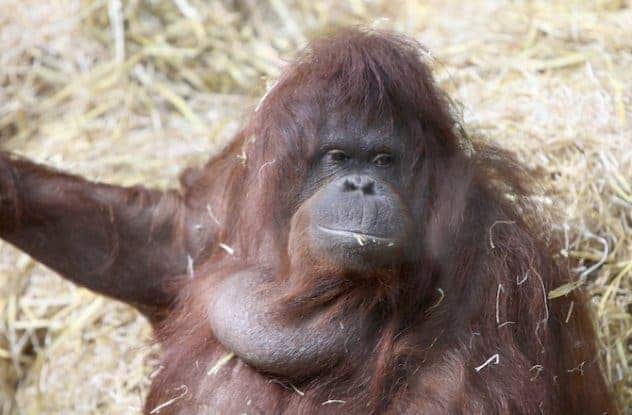A female orangutan born in the wild has learned to use her tongue to whistle and produce vowel sounds just like a human – suggesting that all giant apes are able to do so. Although orangutans are known to create diverse vocalisations, what Tilda can do is unique.
Meet Tilda, the first ever orangutan to make human vocalisations. She can click her tongue producing two calls which were never before observed in any apes, and can create sounds similar to our pronounciation of voiceless consonants (something present in several African languages). Tilda can also whistle.
It’s not clear how she learned to do all this, but it’s believed that it happened because she worked in the “entertainment business”. Tilda’s vocalisations have now been described in a paper in PLOS ONE. She uses these signals to ask for more food, even clapping and pointing in the direction of food. Biologist Adriano Lameira from the University of Amsterdam, explains:
“They are what we would call attention gathering or come-hither calls, which indeed are mostly used when the human caretakers are handling food,” Lameira said. “I would translate them into, ‘Come here and give that food to me!”
It was previously believed that apes don’t have enough control on their vocal structures to emit human-like sounds, but this clearly shows that the theory is wrong.

“The extent of motoric control that great apes exert over their vocal structures, both laryngeal and supra-laryngeal, may be much higher than hitherto presumed,” the authors write in PLOS ONE. The notion that great ape calls are hard-wired and inflexible is likely an artefact of our very poor understanding of the call communication of these species, rather than that their calls are factually hard-wired or inflexible,” Lameira added.
Interestingly, this may not only help us understand if and how apes can speak, but it can also help us understand where our own speech originated from. By further studying how great apes use these sounds, we may finally understand “the conditions that brought together for the first time the two basic building blocks of speech,” as the researchers write.
“The evolutionary origins of speech remain obscure. Recently, it was proposed that speech derived from monkey facial signals which exhibit a speech-like rhythm of ~5 open-close lip cycles per second. In monkeys, these signals may also be vocalized, offering a plausible evolutionary stepping stone towards speech.”
Journal Reference: Adriano R. Lameira, Madeleine E. Hardus, Adrian M. Bartlett, Robert W. Shumaker, Serge A. Wich, Steph B. J. Menken. Speech-Like Rhythm in a Voiced and Voiceless Orangutan Call. Published: January 08, 2015DOI: 10.1371/journal.pone.0116136






